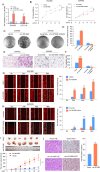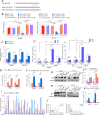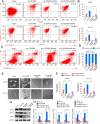Hsa_circ_001680 affects the proliferation and migration of CRC and mediates its chemoresistance by regulating BMI1 through miR-340
- PMID: 32005118
- PMCID: PMC6993513
- DOI: 10.1186/s12943-020-1134-8
Hsa_circ_001680 affects the proliferation and migration of CRC and mediates its chemoresistance by regulating BMI1 through miR-340
Erratum in
-
Correction: Hsa_circ_001680 affects the proliferation and migration of CRC and mediates its chemoresistance by regulating BMI1 through miR-340.Mol Cancer. 2024 May 14;23(1):100. doi: 10.1186/s12943-024-02018-7. Mol Cancer. 2024. PMID: 38741180 Free PMC article. No abstract available.
Abstract
Background: Accumulating evidence indicates that circular RNAs (circRNAs) act as microRNA (miRNA) sponges to directly inhibit specific miRNAs and alter their ability to regulate gene expression at the post-transcriptional level; this mechanism is believed to occur in various cancers. However, the expression level, precise function and mechanism of circ_001680 in colorectal carcinoma (CRC) are largely unknown.
Methods: qRT-PCR was used to detect the expression of circ_001680 and miR-340 in human CRC tissues and their matched normal tissues. Bioinformatics analyses and dual-fluorescence reporter assays were used to evaluate whether circ_001680 could bind to miR-340. Circ_001680 overexpression and knockdown cell lines were constructed to investigate the proliferation and migration abilities in vivo and in vitro through function-based experiments, including CCK8, plate clone formation, transwell, and wounding healing assays. The relationships among circ_001680, miR-340 and BMI1 were investigated by bioinformatics analyses, dual-fluorescence reporter system, FISH, RIP and RNA pull down assays. Sphere forming assays and flow cytometry analyses were used to assess the effect of circ_001680 on the stemness characteristics of CRC cells.
Results: Circ_001680 was more highly expressed in of CRC tissue than in matched adjacent normal tissues from the same patients. Circ_001680 was observed to enhance the proliferation and migration capacity of CRC cells. Furthermore, dual-fluorescence reporter assays confirmed that circ_001680 affects the expression of BMI1 by targeting miR-340. More importantly, we also found that circ_001680 could promote the cancer stem cell (CSC) population in CRC and induce irinotecan therapeutic resistance by regulating the miR-340 target gene BMI1.
Conclusions: Our results demonstrated that circ_001680 is a part of a novel strategy to induce chemotherapy resistance in CRC through BMI1 upregulation. Moreover, circ_001680 may be a promising diagnostic and prognostic marker to determine the success of irinotecan-based chemotherapy.
Keywords: BMI1; Chemotherapy resistance; Has-circ_001680; Irinotecan; Stem cell; miR-340.
Conflict of interest statement
The authors declare that they have no competing interests.
Figures






Similar articles
-
The circular RNA circ-ERBIN promotes growth and metastasis of colorectal cancer by miR-125a-5p and miR-138-5p/4EBP-1 mediated cap-independent HIF-1α translation.Mol Cancer. 2020 Nov 23;19(1):164. doi: 10.1186/s12943-020-01272-9. Mol Cancer. 2020. PMID: 33225938 Free PMC article.
-
Circular RNA circ_0007142 regulates cell proliferation, apoptosis, migration and invasion via miR-455-5p/SGK1 axis in colorectal cancer.Anticancer Drugs. 2021 Jan 1;32(1):22-33. doi: 10.1097/CAD.0000000000000992. Anticancer Drugs. 2021. PMID: 32889894
-
Circular RNA hsa_circ_0004872 inhibits gastric cancer progression via the miR-224/Smad4/ADAR1 successive regulatory circuit.Mol Cancer. 2020 Nov 10;19(1):157. doi: 10.1186/s12943-020-01268-5. Mol Cancer. 2020. PMID: 33172486 Free PMC article.
-
Molecular functions of microRNAs in colorectal cancer: recent roles in proliferation, angiogenesis, apoptosis, and chemoresistance.Naunyn Schmiedebergs Arch Pharmacol. 2024 Aug;397(8):5617-5630. doi: 10.1007/s00210-024-03076-w. Epub 2024 Apr 15. Naunyn Schmiedebergs Arch Pharmacol. 2024. PMID: 38619588 Review.
-
Understanding microRNA-Mediated Chemoresistance in Colorectal Cancer Treatment.Int J Mol Sci. 2025 Jan 29;26(3):1168. doi: 10.3390/ijms26031168. Int J Mol Sci. 2025. PMID: 39940936 Free PMC article. Review.
Cited by
-
Non-Coding RNAs in Colorectal Cancer: Their Functions and Mechanisms.Front Oncol. 2022 Feb 2;12:783079. doi: 10.3389/fonc.2022.783079. eCollection 2022. Front Oncol. 2022. PMID: 35186731 Free PMC article. Review.
-
CircAGO2 promotes colorectal cancer progression by inhibiting heat shock protein family B (small) member 8 via miR-1-3p/retinoblastoma binding protein 4 axis.Funct Integr Genomics. 2023 Mar 7;23(2):78. doi: 10.1007/s10142-023-00990-9. Funct Integr Genomics. 2023. PMID: 36881338
-
Knockdown of circ_0004585 enhances the chemosensitivity of colorectal cancer cells to 5-fluorouracil via the miR-874-3p/CCND1 axis.Histol Histopathol. 2023 Jan;38(1):99-112. doi: 10.14670/HH-18-502. Epub 2022 Jul 18. Histol Histopathol. 2023. PMID: 35900059
-
LncRNA CASC19 Enhances the Radioresistance of Nasopharyngeal Carcinoma by Regulating the miR-340-3p/FKBP5 Axis.Int J Mol Sci. 2023 Feb 3;24(3):3047. doi: 10.3390/ijms24033047. Int J Mol Sci. 2023. PMID: 36769373 Free PMC article.
-
Establishment of a circular RNA regulatory stemness-related gene pair signature for predicting prognosis and therapeutic response in colorectal cancer.Front Immunol. 2022 Jul 25;13:934124. doi: 10.3389/fimmu.2022.934124. eCollection 2022. Front Immunol. 2022. PMID: 35958575 Free PMC article.
References
-
- Lieberman DA, Rex DK, Winawer SJ, Giardiello FM, Johnson DA, Levin TR. Guidelines for colonoscopy surveillance after screening and polypectomy: a consensus update by the US multi-society task force on colorectal Cancer. Gastroenterology. 2012;143(3):844–857. doi: 10.1053/j.gastro.2012.06.001. - DOI - PubMed
Publication types
MeSH terms
Substances
LinkOut - more resources
Full Text Sources
Medical
Miscellaneous

